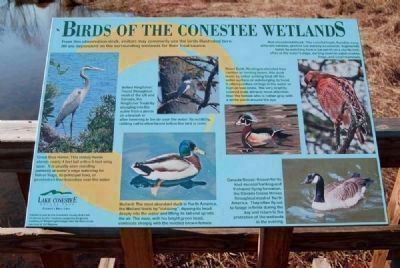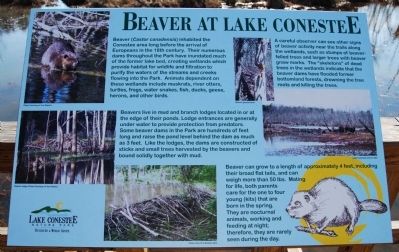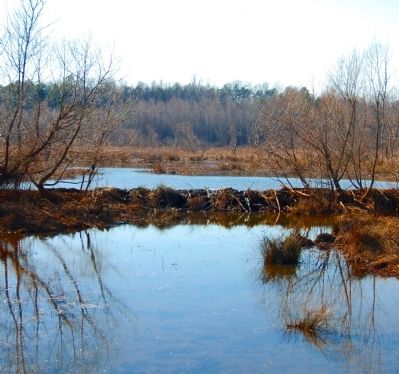Conestee in Greenville County, South Carolina — The American South (South Atlantic)
Beaver at Lake Conestee
Beaver (Castor canadensis) inhabited the Conestee area long before the arrival of Europeans in the 18th century. Their numerous dams throughout the Park have inundated much of the former lake bed, creating wetlands which provide habitat for wildlife and filtration to purify the waters of the streams and creeks flowing into the Park. Animals dependent on these wetlands include muskrats, river otters, turtles, frogs, water snakes, fish, dukes, geese, herons, and other birds.
A careful observer can also see other signs of beaver activity near the trails along the wetlands, such as stumps of beaver gnaw marks. the "skeletons" of dead trees in the wetlands indicate that the beaver dams have flooded former bottomland forests, drowning the tree roots and killing the trees.
Beavers live in mud and branch lodges located in or at the edge of their ponds. Lodge entrances are generally under water to provide protection from predators. Some beaver dams in the Park are hundreds of feet long and raise the pond level behind the dam as much as 3 feet. Like the lodges, the dams are constructed of sticks and small trees harvested by the beavers and bound solidly together with mud.
Beaver can grow to a length of approximately 4 feet, including their broad flat tails, and can weigh more than 50 lbs. Mating for life, both parents care for the one to four young (kits) that are born in the spring. They are nocturnal animals, working and feeding at night; therefore, they are rarely seen during the day.
Erected 2006 by Lake Conestee Nature Park.
Topics. This historical marker is listed in these topic lists: Animals • Natural Resources.
Location. 34° 46.583′ N, 82° 21.283′ W. Marker is in Conestee, South Carolina, in Greenville County. Marker is on Fork Shoals Road. Marker is located in Lake Conestee Nature Park, on the Main Observation Deck. Touch for map. Marker is in this post office area: Conestee SC 29636, United States of America. Touch for directions.
Other nearby markers. At least 10 other markers are within 3 miles of this marker, measured as the crow flies. Lake Conestee in Transition (here, next to this marker); Reedy River Factory (approx. 0.7 miles away); McBee Chapel (approx. 0.7 miles away); McBee Chapel / McBee Methodist Church (approx. 0.7 miles away); Donaldson Air Force Base / Captain John O. Donaldson (approx. 1.7 miles away); a different marker also named Donaldson Air Force Base / Captain John O. Donaldson (approx. 2.1 miles away); Laurel Creek Church (approx. 2.7 miles away); Mauldin United Methodist Church (approx.

Photographed By Brian Scott, February 6, 2009
2. Birds of the Conestee Wetlands Marker
From this observation deck, visitors may commonly see the birds illustrated here. All are dependent on the surrounding wetlands for their food source.
Great Blue Heron: This stately heron stands nearly 4 feet tall with a 6-foot wing span. It is usually seen standing patiently at water's edge watching for fish or frogs, its principal food, or perched on tree branches near the water.
Belted Kingfisher: Found throughout most of the U.S. and Canada, the Kingfisher feeds by plunging into the water from a perch on a branch or after hovering in the air over the water. Its scratchy, rattling call is often heard before the bird is seen.
Mallard: The most abundant duck in North America, the Mallard feeds by "dabbing", dipping its head deeply into the water and lifting its tail end up into the air. The male, with his bright green head, contrasts sharply with the mottled brown female.
Wood Duck: Nesting in elevated tree cavities or nesting boxes, this duck feeds by either picking food off the water surface or submerging its head. It often perches on logs in the water or high on tree limbs. The very brightly colored male attracts more attention than the female who is rather gray with a white patch around the eye.
Canada Goose: Known for its loud musical honking and V-shaped flying formation, the Canada Goose thrives throughout most of North America. They often fly out to forage in fields during the day and return to the protection of the wetlands in the evening.
Red-shouldered Hawk: This colorful hawk, found in many different habitats, prefers low marshy woodlands. It generally hunts by watching from a low perch on a sturdy limb, often at the water's edge, darting down to catch snakes, frogs, and small mammals.
Great Blue Heron: This stately heron stands nearly 4 feet tall with a 6-foot wing span. It is usually seen standing patiently at water's edge watching for fish or frogs, its principal food, or perched on tree branches near the water.
Belted Kingfisher: Found throughout most of the U.S. and Canada, the Kingfisher feeds by plunging into the water from a perch on a branch or after hovering in the air over the water. Its scratchy, rattling call is often heard before the bird is seen.
Mallard: The most abundant duck in North America, the Mallard feeds by "dabbing", dipping its head deeply into the water and lifting its tail end up into the air. The male, with his bright green head, contrasts sharply with the mottled brown female.
Wood Duck: Nesting in elevated tree cavities or nesting boxes, this duck feeds by either picking food off the water surface or submerging its head. It often perches on logs in the water or high on tree limbs. The very brightly colored male attracts more attention than the female who is rather gray with a white patch around the eye.
Canada Goose: Known for its loud musical honking and V-shaped flying formation, the Canada Goose thrives throughout most of North America. They often fly out to forage in fields during the day and return to the protection of the wetlands in the evening.
Red-shouldered Hawk: This colorful hawk, found in many different habitats, prefers low marshy woodlands. It generally hunts by watching from a low perch on a sturdy limb, often at the water's edge, darting down to catch snakes, frogs, and small mammals.
Credits. This page was last revised on February 22, 2021. It was originally submitted on February 7, 2009, by Brian Scott of Anderson, South Carolina. This page has been viewed 1,561 times since then and 76 times this year. Photos: 1. submitted on February 7, 2009, by Brian Scott of Anderson, South Carolina. 2. submitted on June 28, 2009, by Brian Scott of Anderson, South Carolina. 3. submitted on February 7, 2009, by Brian Scott of Anderson, South Carolina.

